Imagine a world where all of the capabilities of your smartphone are incorporated into your field of vision. Maps, information, and communication tools would be readily available, without looking away from what you are doing or where you are going. It may sound like a Terminator fantasy, but engineers at Google call it Project Glass. Unveiled last week, Project Glass aims to replace smartphones with smart glasses, powered by voice command and Google’s Android mobile OS. Google co-founder Sergey Brin has already been spotted wearing a prototype version.
In prototype video, we are presented with a montage of one user’s daily experience. He checks his schedule while making coffee, looks out the window to see weather predictions, and agrees to meet a friend while eating a sandwich. Leaving his apartment, he gets subway service outage information on the fly, instantly getting redirected with walking directions. On the way, he sees a poster for a band he likes and instantly sets a reminder to purchase tickets. At the store, he is directed to the music section by a pop-up store map. After meeting up with his friend, they go to a coffee truck and “check-in” on Google+. Later, he takes and uploads photos within his field of vision, and finally video chats with a girl while showing her the setting sun.
The video suggests that we can all live a faster, more enjoyable, productive life by removing ourselves from the cumbersome limits of smartphone hardware and finger-based software. However, not everyone agrees – Daily Show host Jon Stewart commented on Project Glass, saying “In New York City, that mother****** is going to get hit by a car.” Others raise concerns about privacy, or excessive insertion of advertising content. Despite these worries, there will undoubtedly be millions of customers ready to purchase the final product; estimated to retail at $200-600 dollars.


Comments are closed.